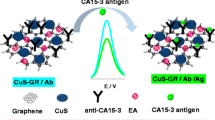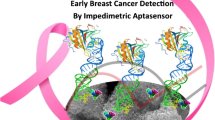Abstract
An electrochemical immunosensor has been fabricated for the early determination of epithelial cell adhesion molecules (EpCAM, tumor biomarker) antigen using reduced graphene oxide (rGO) modified with nanostructured titanium dioxide (TiO2). The hydrothermally synthesized rGO@TiO2 nanocomposite has been electrophoretically deposited on indium tin oxide (ITO) coated glass substrate, and the deposition was confirmed using various spectroscopic, microscopic, and electrochemical techniques. The fabricated rGO@TiO2/ITO electrode shows improved electron transfer kinetics with an electron transfer rate constant of 1.93 × 10−7 cm·s−1. Furthermore, the rGO@TiO2/ITO electrodes were used for the covalent immobilization of monoclonal EpCAM antibodies. Electrochemical determination of the EpCAM cancer biomarker is achieved using differential pulse voltammetry by scanning the potential from − 0.4 to 0.8 V with an amplitude of 50 mV. The rGO@TiO2-based biosensor shows high sensitivity (3.24 μA·mL·ng−1·cm−2), wide detection range (0.01 ng·mL−1 to 60 ng·mL−1), and low detection limit (0.0065 ng·mL−1, S/N = 3). The fabricated biosensor is highly stable and regenerable and has been successfully applied to the determination of EpCAM in spiked human serum samples.

Graphical abstract




Similar content being viewed by others
References
Gorges TM, Tinhofer I, Drosch M, Röse L, Zollner TM, Krahn T, von Ahsen O (2012) Circulating tumour cells escape from EpCAM-based detection due to epithelial-to-mesenchymal transition. BMC Cancer 12:178
Gostner JM, Fong D, Wrulich OA, Lehne F, Zitt M, Hermann M, Krobitsch S, Martowicz A, Gastl G, Spizzo G (2011) Effects of EpCAM overexpression on human breast cancer cell lines. BMC Cancer 11:45
Treerattrakoon K, Chanthima W, Apiwat C, Dharakul T, Bamrungsap S (2017) Oriented conjugation of antibodies against the epithelial cell adhesion molecule on fluorescently doped silica nanoparticles for flow-cytometric determination and in vivo imaging of EpCAM, a biomarker for colorectal cancer. Microchim Acta 184:1941–1950
Patriarca C, Macchi RM, Marschner AK, Mellstedt H (2012) Epithelial cell adhesion molecule expression (CD326) in cancer: a short review. Cancer Treat Rev 38:68–75
Yoon HJ, Kozminsky M, Nagrath S (2014) Emerging role of nanomaterials in circulating tumor cell isolation and analysis. ACS Nano 8:1995–2017
Ntouroupi T, Ashraf S, McGregor S, Turney B, Seppo A, Kim Y, Wang X, Kilpatrick M, Tsipouras P, Tafas T (2008) Detection of circulating tumour cells in peripheral blood with an automated scanning fluorescence microscope. Br J Cancer 99:789–795
Zhao S, Yang H, Zhang M, Zhang D, Liu Y, Liu Y, Song Y, Zhang X, Li H, Ma W (2013) Circulating tumor cells (CTCs) detected by triple-marker EpCAM, CK19, and hMAM RT-PCR and their relation to clinical outcome in metastatic breast cancer patients. Cell Biochem Biophys 65:263–273
Lambrechts AC, Bosma AJ, Klaver S, Top B, Perebolte L, Van't Veer L, Rodenhuis S (1999) Comparison of immunocytochemistry, reverse transcriptase polymerase chain reaction, and nucleic acid sequence–based amplification for the detection of circulating breast cancer cells. Breast Cancer Res Treat 56:219–231
Shen H, Yang J, Chen Z, Chen X, Wang L, Hu J, Ji F, Xie G, Feng W (2016) A novel label-free and reusable electrochemical cytosensor for highly sensitive detection and specific collection of CTCs. Biosens Bioelectron 81:495–502
Li Z, Wang Y, Wang J, Tang Z, Pounds JG, Lin Y (2010) Rapid and sensitive detection of protein biomarker using a portable fluorescence biosensor based on quantum dots and a lateral flow test strip. Anal Chem 82:7008–7014
Shi J, Lyu J, Tian F, Yang M (2017) A fluorescence turn-on biosensor based on graphene quantum dots (GQDs) and molybdenum disulfide (MoS2) nanosheets for epithelial cell adhesion molecule (EpCAM) detection. Biosens Bioelectron 93:182–188
Arya SK, Wang KY, Wong CC, Rahman ARA (2013) Anti-EpCAM modified LC-SPDP monolayer on gold microelectrode based electrochemical biosensor for MCF-7 cells detection. Biosens Bioelectron 41:446–451
Shiddiky MJA, Rauf S, Kithva PH, Trau M (2012) Graphene/quantum dot bionanoconjugates as signal amplifiers in stripping voltammetric detection of EpCAM biomarkers. Biosens Bioelectron 35:251–257
Chikkaveeraiah BV, Bhirde AA, Morgan NY, Eden HS, Chen X (2012) Electrochemical immunosensors for detection of cancer protein biomarkers. ACS Nano 6:6546–6561
Soni A, Pandey CM, Solanki S, Kotnala RK, Sumana G (2018) Electrochemical genosensor based on template assisted synthesized polyaniline nanotubes for chronic myelogenous leukemia detection. Talanta 187:379–389
Zhu Y, Murali S, Cai W, Li X, Suk JW, Potts JR, Ruoff RS (2010) Graphene and graphene oxide: synthesis, properties, and applications. Adv Mater 22:3906–3924
Hussein KH, Abdelhamid HN, Zou X, Woo H-M (2019) Ultrasonicated graphene oxide enhances bone and skin wound regeneration. Mater Sci Eng C 94:484–492
Hallaj R, Haghighi N (2017) Photoelectrochemical amperometric sensing of cyanide using a glassy carbon electrode modified with graphene oxide and titanium dioxide nanoparticles. Microchim Acta 184:3581–3590
Sanghavi BJ, Wolfbeis OS, Hirsch T, Swami NS (2015) Nanomaterial-based electrochemical sensing of neurological drugs and neurotransmitters. Microchim Acta 182:1–41
Ashour RM, Abdelhamid HN, Abdel-Magied AF, Abdel-Khalek AA, Ali MM, Uheida A, Muhammed M, Zou X, Dutta J (2017) Rare earth ions adsorption onto graphene oxide nanosheets. Solvent Extr Ion Exch 35:91–103
Jang HD, Kim SK, Chang H, Roh K-M, Choi J-W, Huang J (2012) A glucose biosensor based on TiO2–graphene composite. Biosens Bioelectron 38:184–188
Josephine DSR, Babu KJ, Gnana Kumar G, Sethuraman K (2017) Titanium dioxide anchored graphene oxide nanosheets for highly selective voltammetric sensing of dopamine. Microchim Acta 184:781–790
Shahriary L, Athawale AA (2014) Graphene oxide synthesized by using modified hummers approach. Int J Renew Energy Environ Eng 2:58–63
Perera SD, Mariano RG, Vu K, Nour N, Seitz O, Chabal Y, Balkus KJ (2012) Hydrothermal synthesis of graphene-TiO2 nanotube composites with enhanced photocatalytic activity. ACS Catal 2:949–956
Pandey CM, Tiwari I, Singh VN, Sood K, Sumana G, Malhotra BD (2017) Highly sensitive electrochemical immunosensor based on graphene-wrapped copper oxide-cysteine hierarchical structure for detection of pathogenic bacteria. Sens Actuators B Chem 238:1060–1069
Srivastava S, Kumar V, Ali MA, Solanki PR, Srivastava A, Sumana G, Saxena PS, Joshi AG, Malhotra BD (2013) Electrophoretically deposited reduced graphene oxide platform for food toxin detection. Nanoscale 5:3043–3051
Fan W, Lai Q, Zhang Q, Wang Y (2011) Nanocomposites of TiO2 and reduced graphene oxide as efficient photocatalysts for hydrogen evolution. J Phys Chem C 115:10694–10701
Randviir EP, Banks CE (2013) Electrochemical impedance spectroscopy: an overview of bioanalytical applications. Anal Methods 5:1098–1115
Randles JEB (1947) Kinetics of rapid electrode reactions. Discuss Faraday Soc 1:11–19
Jorcin J-B, Orazem ME, Pébère N, Tribollet B (2006) CPE analysis by local electrochemical impedance spectroscopy. Electrochim Acta 51:1473–1479
Xie Y, Chen A, Du D, Lin Y (2011) Graphene-based immunosensor for electrochemical quantification of phosphorylated p53 (S15). Anal Chim Acta 699:44–48
Pandey CM, Sumana G, Tiwari I (2014) Copper oxide assisted cysteine hierarchical structures for immunosensor application. Appl Phys Lett 105:103706
Tao L, Zhang K, Sun Y, Jin B, Zhang Z, Yang K (2012) Anti-epithelial cell adhesion molecule monoclonal antibody conjugated fluorescent nanoparticle biosensor for sensitive detection of colon cancer cells. Biosens Bioelectron 35:186–192
Dowaidar M, Abdelhamid HN, Hällbrink M, Zou X, Langel Ü (2017) Graphene oxide nanosheets in complex with cell penetrating peptides for oligonucleotides delivery. BBA-Gen Subjects 1861:2334–2341
Augustine S, Joshi AG, Yadav BK, Mehta A, Kumar P, Renugopalakrishanan V, Malhotra BD (2018) An emerging nanostructured molybdenum trioxide-based biocompatible sensor platform for breast cancer biomarker detection. MRS Commun 8:668–679
Bravo K, Ortega FG, Messina GA, Sanz MI, Fernández-Baldo MA, Raba J (2017) Integrated bio-affinity nano-platform into a microfluidic immunosensor based on monoclonal bispecific trifunctional antibodies for the electrochemical determination of epithelial cancer biomarker. Clin Chim Acta 464:64–71
Chen Q, Hu W, Shang B, Wei J, Chen L, Guo X, Ran F, Chen W, Ding X, Xu Y (2018) Ultrasensitive amperometric aptasensor for the epithelial cell adhesion molecule by using target-driven toehold-mediated DNA recycling amplification. Microchim Acta 185:202
Acknowledgements
C.M. Pandey acknowledges the Department of Science and Technology (DST), New Delhi, India, for DST-INSPIRE Faculty award (Grant No. DST/INSPIRE/04/2015/000932).
Author information
Authors and Affiliations
Corresponding authors
Ethics declarations
Conflict of interest
The authors declare that they have no conflict of interest.
Additional information
Publisher’s note
Springer Nature remains neutral with regard to jurisdictional claims in published maps and institutional affiliations.
Electronic supplementary material
ESM 1
(DOCX 413 kb)
About this article
Cite this article
Jalil, O., Pandey, C.M. & Kumar, D. Electrochemical biosensor for the epithelial cancer biomarker EpCAM based on reduced graphene oxide modified with nanostructured titanium dioxide. Microchim Acta 187, 275 (2020). https://doi.org/10.1007/s00604-020-04233-7
Received:
Accepted:
Published:
DOI: https://doi.org/10.1007/s00604-020-04233-7




